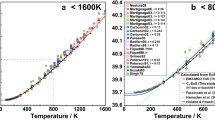Abstract
The paper represents an algorithmic implementation of the SPINMELT-2.0 model designed to simulate Cr-spinel–melt equilibrium, and provides a description of its petrologic options. The properties of the SPINMELT-2.0 model were studied by modeling the topology of the liquidus surface of spinel and its dependence on pressure, redox potential, and concentrations of major components (including Cr2O3 and H2O) in the melt. Reference simulations were carried out for primitive MORB tholeiite. The spinel composition is demonstrated to depend on variously (and often oppositely) acting factors. Providing an accurate estimate of a parental magma composition, the SPINMELT-2.0 program allows one to evaluate a range of P–T–fO2–H2 O parameters responsible for the composition of an original magmatic spinel. The SPINMELT program makes it possible not only to effectively correlate available independent petrological estimates but also to consciously correct them, which is particularly important when the composition of the model melts should be estimated. This is illustrated by the application of the model to data on the composition of rocks and minerals of two young volcanoes in Kamchatka: Tolbachik and Gorely.
Similar content being viewed by others
References
A. A. Ariskin and G. S. Nikolaev, “An empirical model for the calculation of spinel–melt equilibrium in mafic igneous systems at atmospheric pressure: I. Chromian spinels,” Contrib. Mineral. Petrol. 123, 282–292 (1996).
C. Ballhaus, R. F. Berry, and D. H. Green, “High pressure experimental calibration of the olivine–orthopyroxene–spinel oxygen geobarometer: implications for the oxidation state of the upper mantle,” Contrib. Mineral. Petrol. 107 (1), 27–40; Erratum: (1994) Contrib. Mineral. Petrol. 118 (1), 109 (1991).
A. T. Bazilevskii, “Experiments in the olivine–enstatite–Cr-spinel systems,” Geol. Rudn. Mestorozhd., no. 6, 101–105 (1968).
O. A. Braitseva, I. V. Melekestsev, and V. V. Ponomareva, “Age divisions of the Holocene volcanic formations of the Tolbachik Valley,” in The Great Tolbachik Fissure Eruption: Geological and Geophysical Data 1975–1976, Ed. by S. P. Fedotov and Ye. K. Markhinin (Cambridge University Press, Cambridge, 1983), pp. 83–95.
M. Gavrilenko, A. Ozerov, Ph. R. Kyle, M. J. Carr, A. Nikulin, Ch. Vidito, and L. Danyushevsky, “Abrupt transition from fractional crystallization to magma mixing at Gorely volcano (Kamchatka) after caldera collapse,” Bull. Volcanol. 78 (7), #47(2016). doi 10.1007/s00445-016-1038-z
J. S. Huebner, “Buffering techniques for hydrostatic systems at elevated pressures,” in Research Techniques for High Pressure and High Temperatures, Ed. by G. C. Ulmer, (Springer, Berlin–Heidelberg–New York, 1971), pp. 123–177.
T. N. Irvine, “Chromian spinel as a petrogenetic indicator. Part I. Theory,” Can. J. Earth Sci. 2 (6), 648–672 (1965).
S. Jakobsson and N. Oskarsson, “The system C–O in equilibrium with graphite at high pressure and temperature: an experimental study,” Geochim. Cosmochim. Acta 58(1), 9–17 (1994).
D. S. Korzhinskii, “Acid–base interaction of components in silicate melts and the direction of cotectic lines,” Dokl. Akad. Nauk SSSR 128 (2), 383–386 (1959).
A. A. Marakushev, “Acid–alkaline properties of chemical elements and their extremes”, in Acid–Basic Properties of Chemical Elements, Minerals, Rocks, and Natural Solutions, Ed. by A. A. Marakushev and A. D. Rakcheev, (Nauka, Moscow, 1982), pp. 5–39.
N. L. Mironov, and M. V. Portnyagin, “Coupling of Redox State of Mantle Melting and Copper and Sulfur Contents in Primary Magmas of the Tolbachinsky Dol (Kamchatka) and Juan de Fuca Ridge (Pacific Ocean),” Petrology 26(2) (2018).
J. Myers and H. Eugster, “The system Fe–Si–O: oxygen buffer calibrations to 1 500 K,” Contrib. Mineral. Petrol. 82, 75–90 (1983).
G. S. Nikolaev, A. A. Borisov, and A. A. Ariskin, “Calculation of the ferric–ferrous ratio in magmatic melts: testing and additional calibration of empirical equations for various magmatic series,” Geochem. Int. 34 (8), 641–649 (1996).
G. S. Nikolaev, A. A. Ariskin, G. S. Barmina, M. A. Nazarov and R. R. Almeev, “Test of the Ballhaus–Berry–Green Ol–Opx–Sp oxybarometer and calibration of a new equation for estimating the redox state of melts saturated with olivine and spinel,” Geochem. Int. 54 (4), 301–320 (2016).
G. S. Nikolaev, A. A. Ariskin, and G. S. Barmina, SPINMELT-2.0: numerical modeling of the spinel–melt quilibrium in the basaltic systems at pressures up to 15 kbar. I. Formulation, calibration, and testing of the model,” Geochem. Int. 56 (1), 24–45 (2018).
M. Portnyagin, S. Duggen, F. Hauff, N. Mironov, I. Bindeman, M. Thirlwall, and K. Hoernle, “Geochemistry of the Late Holocene rocks the Tolbachik volcanic field, Kamchatka: Quantitative modeling of subductionrelated open magmatic systems,” J. Volcanol. Geoterm. Res. 307, 133–155 (2015). Doi: doi 10.1016/j.jvolgeores.2015.08.015
S. A. Silantyev, N. S. Bortnikov, K. N. Shatagin, Ya. V. Bychkova, E. A. Krasnova, V. E. Bel’tenev, Peridotite–Basalt Association at MAR between 19°42′ and 19°59′ N: Evaluation of Petrogenetic Conditions and Material Balance during Hydrothermal Transformation of the Oceanic Crust. Petrology 23(1), 1–22 (2015).
A. V. Sobolev and L. V. Danyushevsky, “Petrology and geochemistry of boninites from the north termination of the Tonga Trench: constraints on the generation conditions of primary high-Ca boninite magmas,” J. Petrol. 35, 1183–1211 (1994).
A. V. Sobolev, M. V. Portnyagin, L. V Dmitriev, O. P. Tsameryan, L. V. Danyushevskii, N. N. Kononkova, N. Shimizu, and P. Robinson, “Petrology of ultramafic lavas and associated rocks of the Troodos massif, Cyprus,” Petrologiya, 1 (4), 379–412 (1993).
W. R. Taylor and S. F. Foley, “Improved oxygen-buffering techniques for C–O–H fluid-saturated experiments at high pressure,” J.Geophys. Res. 94, 4146–4158 (1989).
Z. Wan, L. A. Coogan, and D. Canil, “Experimental calibration of aluminum partitioning between olivine and spinel as a geothermometer,” Am. Mineral. 93, 1142–1147 (2008).
Author information
Authors and Affiliations
Corresponding author
Additional information
Original Russian Text © G.S. Nikolaev, A.A. Ariskin, G.S. Barmina, 2018, published in Geokhimiya, 2018, No. 2, pp. 135–146.
Rights and permissions
About this article
Cite this article
Nikolaev, G.S., Ariskin, A.A. & Barmina, G.S. SPINMELT-2.0: Simulation of Spinel–Melt Equilibrium in Basaltic Systems under Pressures up to 15 Kbar: II. Description of the Program Package, the Topology of the Cr-spinel–Melt Model System, and Petrological Implications. Geochem. Int. 56, 125–135 (2018). https://doi.org/10.1134/S0016702918020052
Received:
Accepted:
Published:
Issue Date:
DOI: https://doi.org/10.1134/S0016702918020052




